|
|
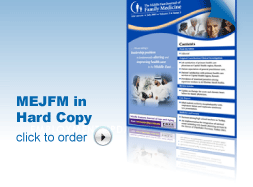 |
Review Paper
........................................................
Education and Training
|
Chief
Editor -
Abdulrazak
Abyad
MD, MPH, MBA, AGSF, AFCHSE
.........................................................
Editorial
Office -
Abyad Medical Center & Middle East Longevity
Institute
Azmi Street, Abdo Center,
PO BOX 618
Tripoli, Lebanon
Phone: (961) 6-443684
Fax: (961) 6-443685
Email:
aabyad@cyberia.net.lb
.........................................................
Publisher
-
Lesley
Pocock
medi+WORLD International
11 Colston Avenue,
Sherbrooke 3789
AUSTRALIA
Phone: +61 (3) 9005 9847
Fax: +61 (3) 9012 5857
Email:
lesleypocock@mediworld.com.au
.........................................................
Editorial
Enquiries -
abyad@cyberia.net.lb
.........................................................
Advertising
Enquiries -
lesleypocock@mediworld.com.au
.........................................................
While all
efforts have been made to ensure the accuracy
of the information in this journal, opinions
expressed are those of the authors and do not
necessarily reflect the views of The Publishers,
Editor or the Editorial Board. The publishers,
Editor and Editorial Board cannot be held responsible
for errors or any consequences arising from
the use of information contained in this journal;
or the views and opinions expressed. Publication
of any advertisements does not constitute any
endorsement by the Publishers and Editors of
the product advertised.
The contents
of this journal are copyright. Apart from any
fair dealing for purposes of private study,
research, criticism or review, as permitted
under the Australian Copyright Act, no part
of this program may be reproduced without the
permission of the publisher.
|
|
|
| November 2014
- Volume 12 Issue 9 |
|
Training
medical students in general practices:
Factors influencing patients' attitudes
R.P.J.C. Ramanayake
(1)
A.H.W. de Silva (2)
D.P. Perera (2)
R.D.N. Sumanasekera (2)
L.A.C.L.Athukorala (3)
K.A.T. Fernando (3)
(1) Senior Lecturer,
Department of Family Medicine, Faculty of Medicine,
University of Kelaniya, Sri Lanka.
(2)
Lecturer,
Department of Family Medicine, Faculty of Medicine,
University of Kelaniya, Sri Lanka.
(3)
Demonstrator. Department of Family Medicine,
Faculty of Medicine, University of Kelaniya,
Sri Lanka.
Correspondence:
Dr. R. P. J. C. Ramanayake
Department of Family Medicine, Faculty of Medicine,
PO Box 6, Talagolla road, Ragama
Sri Lanka
Mobile: 0094773308700
Email: rpjcr@yahoo.com
|
Abstract
Introduction: It is
in the privacy of the consultation room
that a patient divulges information regarding
his/her illness to the doctor. Presence
of students could compromise the privacy
and intimacy and may prohibit a patient
from revealing sensitive information and
allowing internal examination. This study
was conducted to explore factors affecting
patients' attitudes towards training students
in general practices.
Methodology: Six general practices,
to represent different backgrounds (urban,
semi urban, male and female trainers)
where students undergo training, were
selected for the study. Fifty consenting
consecutive adult patients from each practice
responded to a self administered questionnaire
following a consultation where medical
students had been present.
Results: 300 patients (57.2 % females)
participated in the study. 44.1% had previously
experienced students. Patients' agreement
to the presence of students during different
stages of consultation were; 94.7% history
taking, 81.7% examination over clothes,
54% examination without shirt/blouse,
34.7% internal examination. Even though
83.3% agreed to discuss their illness
in the presence of students they were
less prepared to discuss family problems
(58.7%) and sexual problems (38.7%). Females,
younger (<35yrs), more affluent (income
> 20000LKR) and more educated
(>Gr 12) and patients seeing female
GPs were less prepared for internal examination
and discussion of family and sexual problems
in the presence of students. Previous
contact with students and location of
the practice (urban/semi urban) did not
have an impact on patients' attitudes.
Recommendations: General practitioner
trainers should be aware of the instances
where patients are reluctant to have students
during consultation and opportunity should
be offered to them to consult the doctor
without students.
Key words: Medical students, training,
General practice, patients' attitudes,
factors
|
Consultation is the pivot of family medicine and
it is the privacy or intimacy of the consultation
room which provides the patient with the opportunity
of divulging even sensitive personal information
regarding his/her problem to the doctor.(1) Presence
of students in the consultation room may compromise
the privacy and intimacy of consultation and converts
this activity between the doctor and the patient
into a triad.
During the consultation students can learn gathering
information from a patient in an out patient setting
and how to conduct a focused examination. They
can experience every aspect of patient management;
investigations, pharmacological and non pharmacological
management, and referral. This is an opportunity
for them to practice record keeping, writing prescriptions
and referral letters. More importantly this in
an environment where the importance of social,
economic, psychological and cultural influences
on a patient's illness and the family response
can be experienced first hand(2) and it is also
an opportunity for students to get an insight
into the socio-economic environment of patients
and the local resources available to them. General
practice consultations offer a highly personalized
teaching experience for students where teacher
student ratio is either one to one or one to two.
Involvement of students in general practice could
have an impact on the patient, the doctor and
the consultation. Patients may be inhibited by
the presence of students and may not divulge sensitive
information or may postpone internal examination.
Doctors may not be able to conduct the consultation
in the usual manner. Quality of the consultation
could be affected positively or negatively and
duration may become longer.
Patients' attitudes towards students may depend
on patient characteristics(3), the nature of the
problem, (4,5,6) previous experience with students(7,8,9)
and gender of the student.(10,11,12) There could
be a difference in patients' thinking patterns
between an urban practice and a rural practice
and between a practice managed by a male doctor
and a female doctor. Although there have been
numerous studies from the western world on patients'
attitudes towards students such research has been
extremely limited in Sri Lanka and South Asia.
How a different culture in the eastern world has
shaped patient thinking has not been explored
adequately. In this background this study, which
is part of a larger research project on community
based training of undergraduate medical students,
explored factors which affect patients' attitudes
on involvement of students in general practice
consultations.
The Faculty of Medicine, University of Kelaniya,
Sri Lanka sends students to general practices
during their fourth year of training in the five
year course. They learn by observing doctor patient
encounters, taking histories, performing clinical
examinations and getting involved with the management
of patients with the GP teacher. This study was
conducted in general practices where these students
undergo training.
This descriptive cross
sectional study was conducted
in 6 general practices
purposively selected to
represent urban and semi-urban
practices as well as general
practices managed by both
male and female doctors.
A self administered questionnaire
was used to gather demographic
data, number of previous
consultations with student
participation and their
willingness to have presence
of students at different
stages of the consultation
and the factors impacting
upon willingness. Fifty
consenting consecutive
eligible patients from
each practice who consulted
the doctor in the presence
of students were invited
to respond to the questionnaire.
Patients below 16 years,
seriously ill patients,
confused or cognitively
impaired patients, who
were unable to read and
write, were excluded.
Younger patients were
excluded since they may
not be able to respond
to the questionnaire and
the opinion of the guardian
could vary depending on
the relationship to the
patient.
Ethical approval for the
study was obtained from
the ethical review committee
of the faculty of medicine,
University of Kelaniya
and the study was conducted
in 2012.
Out of the 6 general
practitioners 4 were
male doctors, while
3 practices were located
in urban areas.
Table 1: Demographic
details of patients
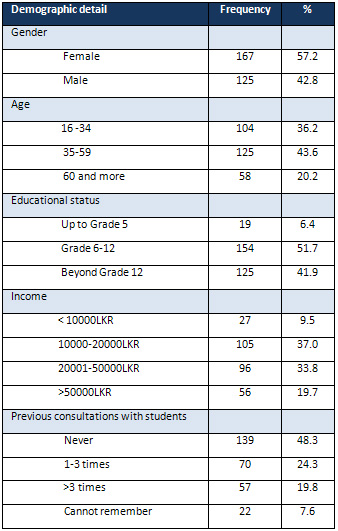
n=300 note: Percentages
expressed are of valid
responses for a given
item, not for the entire
sample
Graph 1: Patients'
overall response to
student involvement
during consultation
in different situations
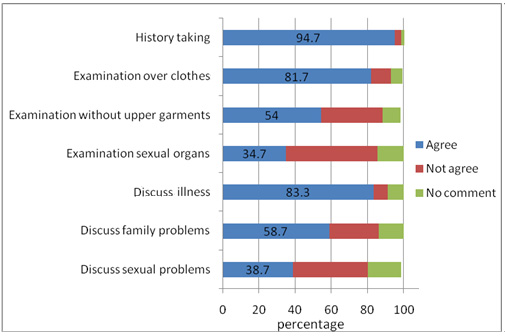
Click here for Table
2: Percentage of patients
who agreed to participation
of students according
to their demographic
factors and previous
experience with students
Table 3: Percentage
of patients who agreed
to participation of
students according to
practice characteristics
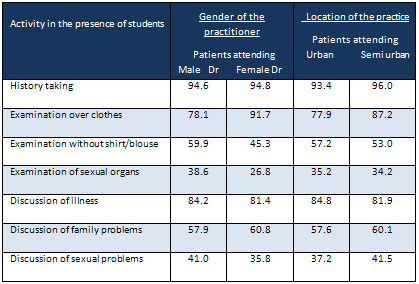
Table 4: Patients'
attitudes towards gender
of students
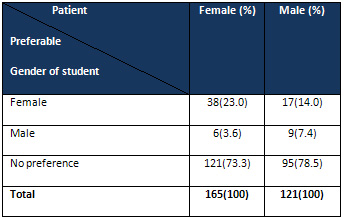
Pearson Chi square =5.099
p= 0.012
Patients' responses
show their positive
attitudes towards students
but it was evident that
the reason for consultation
and the nature of the
physical examination
required influenced
their decision. Even
though more than 90%
of the patients agreed
to the presence of students
during history taking,
there was resistance
to their presence during
examination. There was
a step wise decline
in the consent rate
from examination over
clothes to examination
of genital organs. This
has been a universal
phenomenon. Wright(3)
in 1974 and Choudhury
et al(9) in 2006 among
British patients and
Salisbury et al(5) in
2004 among Australian
patients observed that
there is a lesser degree
of acceptance of students
during examination compared
to history taking.
While there was little
reluctance to discuss
physical illness patients
were less prepared to
discuss family problems
and sexual problems
in the presence of students..
Research also suggested
that consent for a student
to be present is given
more readily for physical
rather than psychological
complaints(7,9,13,14)
and presence of students
could be a problem in
consultations that involved
emotional upset, internal
examinations, and sexual
problems.(15,16)
Their responses were
analysed to see if demographic
factors affect their
decisions. Gender based
analysis showed that
females were more reluctant
to have students when
it comes to internal
examination. Wright(3)
in 1974 and O'Flynn
et al(4) in 1997 described
similar difference in
attitudes between males
and females. In general
older patients were
more willing to have
students. That was more
marked for internal
examinations and discussion
of sexual problems.
Similarly patients with
better monthly income
also showed a degree
of reluctance to involvement
of students. There was
resistance among more
educated patients as
well. Earlier studies
revealed social class
had no influence on
patients' attitudes
towards students.(3,8)
The previous experience
of students had not
affected patients' attitudes
contrary to other studies
which showed that such
experience was a positive
predictor for more active
student involvement.(7,8,9)
Patients attending female
general practitioners
were more resistant
to examination without
clothes and internal
examination while there
was no difference in
their attitudes towards
students among patients
attending urban general
practices and semi urban
general practices.
Gender of the student
mattered more for female
patients. 23% of the
females preferred involvement
of female students compared
to 7.4% among males
even though this difference
was not statistically
significant. Chipp et
al(11) and Bentham et
al(10) also found that
women preferred a student
of their own sex more
often than men.
This study analysed
the effect of the nature
of the problem, demographic
factors of patients,
previous experience
of students, practice
characteristics and
gender of the student
on the thinking pattern
of patients. Nature
of the problem and type
of examination seem
to influence whether
they like the presence
of students or not most.
In general patients'
attitudes do not seem
to be quite different
from that of patients
in western countries.
•
Patients
are
willing
to
have
students
during
consultation
but
the
most
important
determinants
are
the
nature
of
the
problem
and
the
extent
of
the
examination
required.
•
Females
and
younger
patients
are
more
reluctant
to
the
presence
of
students
in
internal
examinations
and
discussion
of
sexual
problems.
•
More
affluent
and
more
educated
patients
are
less
prepared
to
have
students
during
consultation
•
More
female
patients
prefer
interaction
with
female
students
General
practitioner
trainers
should
be
aware
of
the
instances
where
patients
are
reluctant
to
have
students
during
consultation
and
opportunity
should
be
offered
to
them
to
consult
the
doctor
without
students.
1.
De
Silva
Nandani.
The
consultation
and
doctor
patient
relationship.
Lecture
notes
in
Family
Medicine.
2nd
edition.
Sarvodaya
Vishwa
Lekha
publication;
2006.
P
20.
2.
Lefford
F,
Mccroriet
P,
Perrins
F.
A
survey
of
medical
undergraduate
community-
based
teaching:
taking
undergraduate
teaching
into
the
community.
Medical
Education
1994;28:
312-315
3.
Wright
H.
J.
Patients'
Attitudes
to
Medical
Students
in
General
Practice.
Br
Med
J.
1974
Mar
2;
1(5904):
372-376
4.
O'Flynn
N,
Spencer
J,
Jones
R.
1997.
Consent
and
confidentiality
in
teaching
in
general
practice:
Survey
of
patients'
views
on
presence
of
students.
BMJ
315:1142.
5.
Salisbury
K,
Farmer
EA,
Vnuk
A.
2004.
Patients'
views
on
the
training
of
medical
students
in
Australian
general
practice
settings.
Austr
Fam
Physician
33:281-283.
6.
Haffling
AC,
Hakansson
A.
2008.
Patients
consulting
with
students
in
general
practice:
Survey
of
patients'
satisfaction
and
their
role
in
teaching.
Med
Teach
30:
622-629.
7.
Cooke
F,
Galasko
G,
Ramrakha
V,
Richards
D,
Rose
A,
Watkins
J.
1996.
Medical
students
in
general
practice:
How
do
patients
feel?
Br
J
Gen
Pract
46:361-
362.
8.
Devera-Sales
A,
Paden
C,
Vinson
DC.
1999.
What
do
family
medicine
patients
think
about
medical
students'
participation
in
their
health
care?
Acad
Med
74(5):550-552.
9.
Choudhury
TR,
Moosa
A,
Cushing
A,
Bestwick
J.
2006.
Patients'
attitudes
towards
the
presence
of
medical
students
during
consultations.
Med
Teach
28:198-203.
10.
Bentham
J,
Burke
J,
Clark
J,
Svoboda
C,
Vallance
G,
Yeow
M.
1999.
Students
conducting
consultations
in
general
practice
and
the
acceptability
to
patients.
Med
Educ
33:686-687.
11.
Chipp
E,
Stoneley
S,
Cooper
K.
2004.
Clinical
placements
for
medical
students:
Factors
affecting
patients'
involvement
in
medical
education.
Med
Teach
26:114-119.
12.
Passaperuma
K,
Higgins
J,
Power
S,
Taylor
T.
Do
patients'
comfort
levels
and
attitudes
regarding
medical
student
involvement
vary
across
specialties?
Med
Teach
2008;30(1):48-54.
13.
Benson
J,
Quince
T,
Hibble
A,
Fanshawe
T,
Emery
J.
Impact
on
patients
of
expanded,
general
practice
based,
student
teaching:
observational
and
qualitative
study.
BMJ
2005;331:89
14.
Mol
SSL,
Peelen
JH,
Kuyvenhoven
MM.
Patients'
views
on
student
participation
in
general
practice
consultations:
A
comprehensive
review.
Medical
Teacher
2011:33;e397-e
400.
15.
Monnickendam
SM,
Vinker
S,
Zalewski
S,
Cohen
O,
Kitai
E.
Patients'
attitudes
towards
the
presence
of
medical
students
in
family
practice
consultations.
Isr
Med
Assoc
J.
2001;3(12):903-6.
16.
Sweeney
K,
Magin
PJ,
Pond
D.
Patient
attitudes
Training
students
in
general
practice.
Australian
family
physician
2010;39:9:676-682
|
|
.................................................................................................................

|
| |
|

